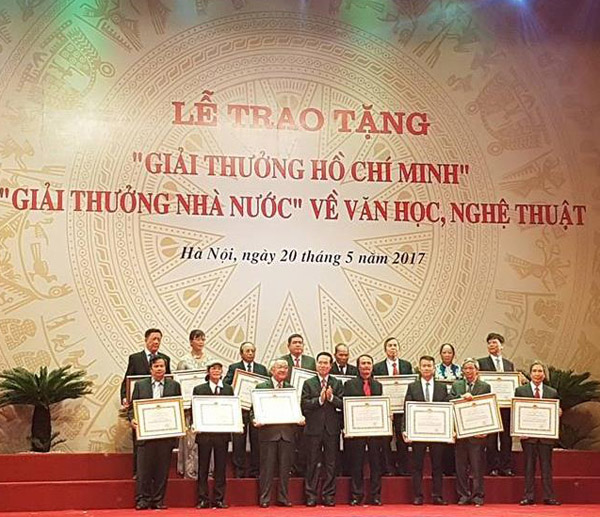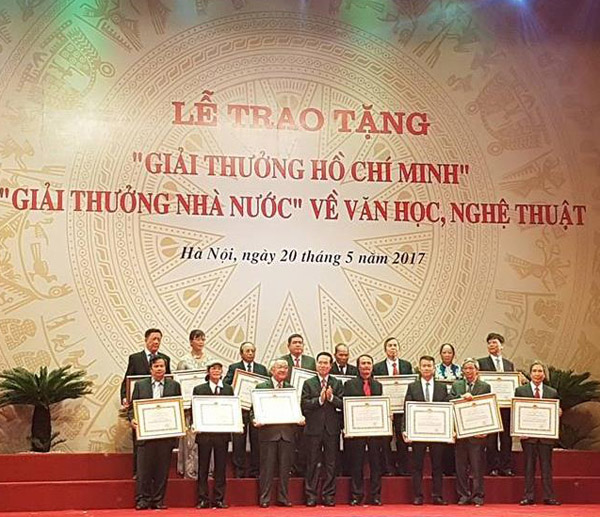
(HBO) - Meritorious artist
Bui Huy Vong from the
northern
province of Hoa Binh was among 113 authors and late
authors nationwide honoured with the Ho Chi Minh
Awards and State Prize in
Literature and Arts in
2017, the highest ranking award
of its kind in the country.

Politburo member, Secretary of the Central Party Committee and head of the Party Central
Committee's Information and Education Commission Vo Van Thuong and 2017
Award winners at the honouring ceremony.
He won the State prize for works relating to traditional funeral rites of
Muong ethnic group in Hoa Binh.
Artist Bui Huy Vong is a Muong ethnic. He was born in
1967 in Bung hamlet, Huong
Nhuong commune, Lac Son district.
He is a member of the provincial Association of Literature and Arts, the Folk Arts Association of Vietnam, and the Literature and Arts
Association of Vietnamese Ethnic Minorities.
During his career, he has written 80 articles and studies, published 12 books and
joined two scientific research projects. He has won 10 awards at the provincial
level, and one State-level award.
At present, Vong is participating in scientific research projects related to
preserving and promoting the values of Mo Muong- a special culture heritage of
Muong people in Hoa Binh, and building the alphabet of Muong scripts, among
others.
Bui Huy
With an increasingly vibrant and widespread emulation movement aimed at building cultured residential areas and cultured families, Yen Thuy District has been making steady progress toward improving both the material and spiritual well-being of its people, while fostering a civilized, prosperous, beautiful, and progressive community.
Once lacking recreational spaces and community facilities, Residential Group 2 in Quynh Lam Ward (Hoa Binh City) has recently received attention for the construction of a new, spacious, and fully equipped cultural house. The project followed the model of state support combined with public contributions in both labor and funding.
The "All people unite to build cultural life" movement, which has been effectively integrated with Kim Boi district’s socio-economic development goals, is fostering a lively spirit of emulation across local residential areas, hamlets, villages, public agencies, and enterprises. In addition, through the initiative, traditional cultural values are being preserved and promoted, while community solidarity and mutual support in poverty reduction and economic development are being strengthened.
A working delegation of the Hoa Binh provincial People’s Committee led by its Permanent Vice Chairman Nguyen Van Toan on June 11 inspected the progress of a project to build the Mo Muong Cultural Heritage Conservation Space linked to tourism services in Hop Phong commune, Cao Phong district.
Born and growing in the heroic land of Muong Dong, Dinh Thi Kieu Dung, a resident in Bo town of Kim Boi district, in her childhood was nurtured by the sweet lullabies of her grandmother and mother. These melodies deeply imprinted on her soul, becoming an inseparable part of her love for her ethnic group's culture. For over 20 years, this love for her hometown has driven Dung to research, collect, and pass down the cultural values of the Muong people to future generations.
In the final days of May, the Ethnic Art Troupe of Hoa Binh Province organized performances to serve the people in remote, mountainous, and particularly disadvantaged areas within the province. These were not just ordinary artistic shows, but they were the meaningful journeys aimed at spreading cultural values, enhancing the spiritual life of the people and contributing to the preservation of ethnic minority cultural identities.



